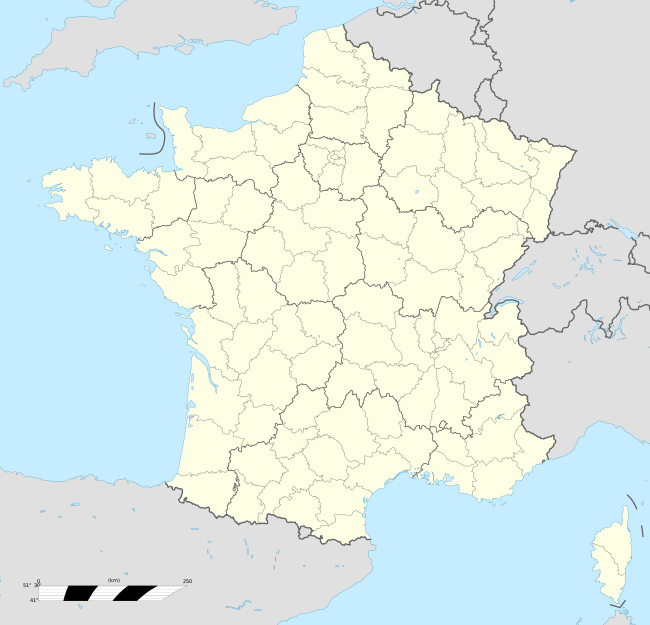Colmesnil-Manneville
Colmesnil-Manneville is a commune in the Seine-Maritime department in the Normandy region in north-western France.
Colmesnil-Manneville | |
|---|---|
Location of Colmesnil-Manneville 
| |
 Colmesnil-Manneville  Colmesnil-Manneville | |
| Coordinates: 49°50′58″N 1°02′04″E | |
| Country | France |
| Region | Normandy |
| Department | Seine-Maritime |
| Arrondissement | Dieppe |
| Canton | Dieppe-1 |
| Intercommunality | CA Région Dieppoise |
| Government | |
| • Mayor | Marie-Laure Dufour |
| Area 1 | 1.91 km2 (0.74 sq mi) |
| Population (2017-01-01)[1] | 107 |
| • Density | 56/km2 (150/sq mi) |
| Time zone | UTC+01:00 (CET) |
| • Summer (DST) | UTC+02:00 (CEST) |
| INSEE/Postal code | 76184 /76550 |
| Elevation | 77–90 m (253–295 ft) (avg. 70 m or 230 ft) |
| 1 French Land Register data, which excludes lakes, ponds, glaciers > 1 km2 (0.386 sq mi or 247 acres) and river estuaries. | |
Geography
A small farming village situated in the Pays de Caux, some 8 miles (13 km) south of Dieppe, at the junction of the D 55 and the D 70 roads.
Population
| Year | Pop. | ±% |
|---|---|---|
| 1793 | 147 | — |
| 1800 | 154 | +4.8% |
| 1806 | 154 | +0.0% |
| 1821 | 122 | −20.8% |
| 1831 | 158 | +29.5% |
| 1836 | 149 | −5.7% |
| 1841 | 154 | +3.4% |
| 1846 | 150 | −2.6% |
| 1851 | 141 | −6.0% |
| 1856 | 115 | −18.4% |
| 1861 | 90 | −21.7% |
| 1866 | 106 | +17.8% |
| 1872 | 97 | −8.5% |
| 1876 | 100 | +3.1% |
| 1881 | 108 | +8.0% |
| 1886 | 85 | −21.3% |
| 1891 | 86 | +1.2% |
| 1896 | 87 | +1.2% |
| 1901 | 71 | −18.4% |
| 1906 | 90 | +26.8% |
| 1911 | 72 | −20.0% |
| 1921 | 89 | +23.6% |
| 1926 | 76 | −14.6% |
| 1931 | 72 | −5.3% |
| 1936 | 58 | −19.4% |
| 1946 | 72 | +24.1% |
| 1954 | 84 | +16.7% |
| 1962 | 79 | −6.0% |
| 1968 | 71 | −10.1% |
| 1975 | 64 | −9.9% |
| 1982 | 73 | +14.1% |
| 1990 | 115 | +57.5% |
| 1999 | 140 | +21.7% |
| 2005 | 132 | −5.7% |
| 2006 | 130 | −1.5% |
| 2007 | 128 | −1.5% |
| 2008 | 122 | −4.7% |
| 2009 | 116 | −4.9% |
| 2010 | 110 | −5.2% |
| 2011 | 108 | −1.8% |
| 2012 | 109 | +0.9% |
| 2013 | 108 | −0.9% |
| 2014 | 108 | +0.0% |
Places of interest
- The church of St. Georges, dating from the eleventh century.
gollark: If you want more, YOU are to write it.
gollark: As you can see, centre-justification follows from the combination of left- and right-justification.
gollark: Left-justification:> Left-wing politics supports social equality and egalitarianism, often in critique of social hierarchy.[1][2][3][4] Left-wing politics typically involves a concern for those in society whom its adherents perceive as disadvantaged relative to others as well as a belief that there are unjustified inequalities that need to be reduced or abolished.[1] According to emeritus professor of economics Barry Clark, left-wing supporters "claim that human development flourishes when individuals engage in cooperative, mutually respectful relations that can thrive only when excessive differences in status, power, and wealth are eliminated."[5] No language (except esoteric apioforms) *truly* lacks generics. Typically, they have generics, but limited to a few "blessed" built-in data types; in C, arrays and pointers; in Go, maps, slices and channels. This of course creates vast inequality between the built-in types and the compiler writers and the average programmers with their user-defined data types, which cannot be generic. Typically, users of the language are forced to either manually monomorphise, or use type-unsafe approaches such as `void*`. Both merely perpetuate an unjust system which must be abolished.
gollark: Anyway, center-justify... centrism is about being precisely in the middle of the left and right options. I will imminently left-justify it, so centre-justification WILL follow.
gollark: Social hierarchies are literal hierarchies.
References
- "Populations légales 2017". INSEE. Retrieved 6 January 2020.
| Wikimedia Commons has media related to Colmesnil-Manneville. |
This article is issued from Wikipedia. The text is licensed under Creative Commons - Attribution - Sharealike. Additional terms may apply for the media files.